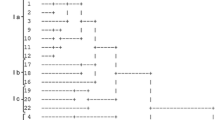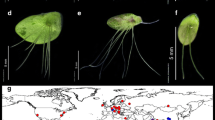Abstract
Two Sargassum species (S. baccularia and S. polycystum) collected from Teluk Kemang and Cape Rachado, Port Dickson, Negeri Sembilan, Malaysia, which are alike in morphology except for the rhizoidal system and vesicles, were characterised using random amplified polymorphism DNA (RAPD). The genomic DNA of both species was isolated from the leaves using a modified CTAB method. Four random primers, that is, OPA2, OPA3, OPA4 and OPA13, successfully amplified the DNA. The polymorphisms generated by these four primers were analysed using the Dice Coefficient of Similarity and cluster analysis was carried out using GelCompar II Version 2.0 (Applied Maths, Kortrijk, Belgium) based on UPGMA. DNA analysis showed that three primers were able to differentiate the two species. Morphological analysis using Principal Components Analysis (PCA) and discriminant function analysis supported the molecular data. Both species are characterised by heavily muricate main branches, oblong-lanceolate leaves with dentate margins and discoid holdfasts and spherical vesicles; both are dioecious. The only difference is that S. polycystum has secondary holdfasts transformed into stolons. This last characteristic is therefore a very important criterion and may contribute to the difference shown by DNA analysis.
Similar content being viewed by others
References
Ajisaka T (2002) Sargassum specimens from Singapore and Malaysia in the herbarium of the Bishop Museum. In Abbott IA, McDermid K (eds), Taxonomy of Economic Seaweeds with Reference to some Pacific Species VIII. California Sea Grant College, University of California, La Jolla, California, pp. 77–88.
Ajisaka T, Phang SM, Yoshida T (1999) Preliminary report of Sargassum species collected from Malaysian coast. In Abbott IA (ed), Taxonomy of Economic Seaweeds with Reference to Some Pacific Species VII. California Sea Grant College, University of California, La Jolla, California, pp. 23–42.
Billot C, Boury S, Benet H, Kloareg B (1999) Development of RAPD markers for parentage analysis in Laminaria digitata. Bot. Mar. 42: 307–314.
Chiang YM, Yoshida T, Ajisaka T, Trono G, Tseng CK, Lu B (1992) Distribution and variation in Sargassum polycystum C.A. Agardh (Fucales, Phaeophyta). In Abbott IA (ed), Taxonomy of Economic Seaweeds with Reference to Some Pacific and Western Atlantic Species III. California Sea Grant College, University of California, La Jolla, California, pp. 35–42.
De Ruyter Van Steveninck ED, Breeman AM (1987) Population dynamics of a tropical intertidal and deep-water population of Sargassum polyceratium (Phaeophyceae). Aquat. Bot. 29: 139–156.
Engelen AH, Olsen JL, Breeman AM, Stam WT (2001) Genetic differentiation in Sargassum polyceratium (Fucales: Phaeophyceae) around the island of Curacao (Netherlands Antilles). Mar. Biol. 139: 267–277.
Hadrys H, Balick M, Schierwater B (1992) Application of random amplified polymorphic DNA (RAPD) in molecular ecology. Mol. Ecol. 1: 55–63.
Ho CL, Phang SM, Pang T (1995a) Application of polymerase chain reaction (PCR) using random amplified polymorphic DNA (RAPD) primers in molecular identification of selected Sargassum species (Phaeophyta, Fucales). Eur. J. Phycol. 30: 273–280.
Ho CL, Phang SM, Pang T (1995b) Molecular characterization of Sargassum polycystum and S. siliquosum (Phaeophyta) by polymerase chain reaction (PCR) using random amplified polymorphic DNA (RAPD) primers. J. Appl. Phycol. 7: 33–41.
Koh CH, Kim Y, Kang SG (1993) Size distribution, growth and production of Sargassum thunbergii in an intertidal zone of Padori, west coast of Korea. Hydrobiologia 260/261: 207–214.
Largo DB, Ohno M (1992) Phenology of two species of brown seaweeds, Sargassum myriocystum J. Agardh and Sargassum siliquosum J. Agardh (Sargassaceae, Fucales) in Liloan, Cebu, in Central Philippines. Bull. Mar. Sci. Fish, Kochi Univ. 12: 17–27.
Lim PE, Thong KL, Phang SM (2001) Molecular differentiation of two morphological variants of Gracilaria salicornia. J. Appl. Phycol. 13: 335–342.
Meneses I (1996) Assessment of populations of Gracilaria chilensis (Gracilariales, Rhodophyta) utilizing RAPDs. J. Appl. Phycol. 8: 185–192.
Park JW, Cho YC, Nam BH, Jin HJ, Sohn CH, Hong YK (1998) RAPD identification of genetic variation in seaweed Hizikia fusiformis (Fucales, Phaeophyta). J. Mar. Biotechnol. 6: 62–64.
Phang SM (1998) The seaweed resources of Malaysia. In Critchley AT, Ohno M (eds), Seaweed Resources of the World, JICA, pp. 79–91.
Phang SM, Yoshida T (1997) Sargassum stolonifolium Phang et Yoshida sp. nov. from Penang Island, Peninsular Malaysia. In Abbott IA (ed), Taxonomy of Economic Seaweeds with Reference to Some Pacific Species VI. California Sea Grant College, University of California, La Jolla, California, pp. 61–74.
Sheath RG (1989) Application of image analysis and multivariate morphometrics for algal systematics. J. Phycol. 23: 3–5.
Teo LW, Wee YC (1983) Seaweeds of Singapore. Singapore {University} Press, National University of Singapore, Singapore, 123 pp.
Trono GC (1992) The genus Sargassum in the Philippines. In Abbott IA (ed), Taxonomy of Economic Seaweeds with Reference to Some Pacific and Western Atlantic Species III. California Sea Grant College, University of California, La Jolla, California, pp. 43–94.
Tseng CK, Lu B (1992) Studies on the malacocarpic Sargassum of China: II. Racemosae J. Agardh. In Abbott IA (ed), Taxonomy of Economic Seaweeds with Reference to Some Pacific and Western Atlantic Species III. California Sea Grant College, University of California, La Jolla, California, pp. 11–34.
Valatka S, Makinen A, Yli-Mattila T (2000) Analysis of genetic diversity of Furcellaria lumbricalis (Gigartinales, Rhodophyta) in the Baltic Sea by RAPD-PCR technique. Phycologia 39(2): 109–117.
Williams JGK, Kubelik AR, Livak KJ, Rafalski JA, Tingey S (1990) DNA polymorphisms amplified by arbitrary primers are useful as genetic markers. Nucl. Acids Res. 18: 6531–6535.
Wong CL, Phang SM (2004) Biomass production of two Sargassum species at Cape Rachado, Malaysia. Hydrobiologia 512: 79–88.
Author information
Authors and Affiliations
Corresponding author
Rights and permissions
About this article
Cite this article
Wong, CL., Gan, SY. & Phang, SM. Morphological and molecular characterisation and differentiation of Sargassum baccularia and S. polycystum (Phaeophyta). J Appl Phycol 16, 439–445 (2004). https://doi.org/10.1007/s10811-004-5504-1
Received:
Revised:
Accepted:
Issue Date:
DOI: https://doi.org/10.1007/s10811-004-5504-1




